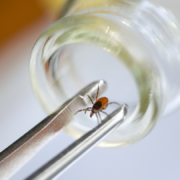Does Lyme Disease Go Away On Its Own?
We all know that certain infections, like the common cold, influenza, and even some cases of coronavirus, will go away on their own. But does Lyme disease go away on its own?
Perhaps you’re wondering about this because you recently got bit by a deer tick and have the tell-tale erythema migrans or bull’s eye rash on your body. Or maybe you don’t have the Lyme Disease rash, but you spotted a deer tick on you while going for a hike.
Are you in the early stages of Lyme disease? Should you panic and get treated immediately? Obviously, panicking is never a good idea. But what’s also not a good idea is hoping that Lyme disease will go away on its own—if you are indeed infected.
Thankfully, Innovative Medicine offers several non-conventional therapeutic approaches to overcoming Lyme disease.
But let’s not get ahead of ourselves because if you recently got bit by a black-legged deer tick, you may still be in the clear…
Not All Deer Tick Bites Produce Lyme Disease
The good news is that not every deer tick carries in its salivary glands the Borrelia burgdorferi bacteria that causes Lyme disease. In fact, most people who are bitten by this tiny vampire-like arachnid (fact check: ticks are not insects) will not develop Lyme disease. This is either because the bite was not caused by an infected tick or because a person’s immune system can neutralize the bacterium.
But obviously, for some of the nearly estimated 475,000 people a year who are diagnosed and treated for Lyme disease, the immune system can become overwhelmed, and recovery can take a long time.
Why The Conventional Approach To Treating Lyme Disease Doesn’t Always Work
To repeat, even if you think you have a very strong immune system, banking on the fact that your Lyme disease will go away on its own is taking a big gamble. While you should always believe in the power of manifesting health, with both acute and chronic Lyme disease, you don’t want to go it alone. Yes, it’s possible you can be one of the lucky ones and have the infection clear out on its own. But you also run the risk of the infection laying dormant and rearing its ugly head later.
With that said, however, the conventional approach to treating Lyme disease is sometimes unsuccessful. This is for three primary reasons:
1. False-Negative Results
Both the enzyme immunosorbent assay (ELISA) test and Western blot test that look for the presence of Lyme disease antibodies cannot be performed during the first few weeks of the initial infection.
This is because it takes time for your immune system to mount a defense. If you get tested too quickly, there may not be any antibodies built up yet. This means that the test to detect Lyme disease will come back negative. You’ll go home thinking, yes, my Lyme disease went away on its own when in fact, it’s just getting started.
(This Lyme Disease test may be more reliable).
2. Antibiotics Can Hinder Immune Function
Most cases of Lyme disease can be cured with a 2- to 4-week course of oral antibiotics such as amoxicillin and cefuroxime. But that’s not always the case. According to the Centers for Disease Control and Prevention, patients can sometimes have symptoms of pain, fatigue, or difficulty thinking that last for more than six months after they finish antibiotic treatment. This condition is called Post-Treatment Lyme Disease Syndrome (PTLDS).
But even if one short course of antibiotics proves successful at first, this conventional Lyme disease treatment may have pitfalls.
First, antibiotics act like a nuclear bomb in your large intestine, killing not only the harmful bacteria that cause Lyme disease but also a metropolis-worth of friendly bacteria. This creates gut dysbiosis, which in turn can negatively impact the immune system. This is due to the fact that approximately 70% of your immune system cells reside in the gut.
For those people who don’t get Lyme disease diagnosed in the early stages, a month’s worth of antibiotics or more may be necessary. In some instances, IV antibiotics may be required. But even with multiple courses of antibiotics, there’s no guarantee that the Borrelia burgdorferi bacteria will be completely eradicated.
For an invisible universe, your gut microbiome has such an oversized influence on your overall wellness. Thus, the blitzkrieg of antibiotics on your friendly bacteria may not only harm your immune system, but it can also lead to mood imbalances and other problems.
3. Treating Lyme Disease Requires A Holistic Approach
When you take your car in to get serviced, the mechanic doesn’t just look at the tailpipe. The mechanic uses a diagnostic machine to look at the total health of the car. Likewise, treating Lyme disease takes a multi-systemic approach.
The Innovative Medicine approach to treating Lyme disease involves a multi- non-invasive therapeutic approach that boosts the body’s detoxification system in order to rid the body of microbial threats, be they latent, acute, or chronic.
In addition, we offer several stress-management techniques that boost the internal vibration and immune system. In the end, this better enables you to eradicate the bacteria that causes Lyme disease. Your own body’s natural defenses will be bolstered, and you’ll have lower inflammation. Or, another way to put it, your body’s ability to achieve homeostasis will be restored.
Non-Conventional Treatment of Lyme Disease
If you’re looking for a non-conventional approach Innovative Medicine offers the best post-Lyme disease recovery therapies to optimize recovery.
Here’s a brief look at 5 of the alternative therapies we offer:
Matrix Regeneration Therapy
A non-invasive detoxification therapy that combines:
- Cupping therapy
- Deep current treatment
- Bioresonance therapy
Learn more about Matrix Regeneration Therapy
Lymphatic Massage
Getting a massage should be incentive enough not to just wish that your Lyme disease will go away on its own. While lymphatic drainage massage is not necessarily the same thing as a 5-star spa Swedish massage indulgence, the therapy is relaxing. Like fixing a clogged-up garbage disposal, lymphatic massage may help naturally release and remove toxins from the body.
When lymph nodes are free of their toxic burden, the function of the immune system is improved and inflammation is kept in check.
Learn more about Lymphatic Massage
Biomagnetic Therapy
Most states of disease thrive in an acidic environment. To increase your chances of being able to purge viruses, bacteria, parasites and fungus from the body without harm, your body’s pH level should be as close to 7.6 as possible. This pH level is slightly alkaline. Biomagnetic therapy may help the body’s cellular environment achieve a more optimal pH level in which pathogens cannot survive.
Learn more about Biomagnetic Therapy
Neuro Emotional Technique (NET)
Lyme disease doesn’t only affect the body physically. For some people, the condition is as much of an emotional roller coaster. Chronic Lyme disease is a source of intense stress, trauma, and frustration and may even contribute to depression and anxiety.
NET helps alleviate stuck emotional patterns.
Learn more about Neuro-Emotional Technique
NAET Allergy Elimination Therapy
If you have any allergies, having chronic Lyme disease may more easily trigger those allergies. And your allergic responses may be more severe. NAET is a therapy that combines a myriad of disciplines such as acupressure, nutrition, and kinesiology, to better regulate the immune response and dampen hyperactive mast cell response.
Learn more about Nambudripad’s Allergy Elimination Technique
Don’t Wait For Lyme Disease To Go Away On Its Own
Even if you don’t have any symptoms at present, they may manifest later, and symptoms of Lyme disease are not fun. These can include:
- Arthritis and joint pain (aka Lyme arthritis)
- Migraines
- Flu-like symptoms
- Brain fog
- Memory loss and other neurological imbalances
- Muscle aches
- Nervous system dysfunction such as palsy
- Cardiovascular problems such as carditis and heart palpitations
- Extreme fatigue and insomnia
Get the point?
No one will blame you if you don’t want to receive yet another course of antibiotic treatment or if you’d rather stick a needle in your eye than get another blood test.
But not doing anything about Lyme disease may come back to bite you later (pardon the pun).

Does Lyme Disease Go Away On Its Own? Conclusion
Hate going to the doctor? It’s understandable. But don’t risk developing chronic Lyme disease either. As you can see from the symptoms above, chronic Lyme disease is not a bacterial infection to take lightly; it may not be something you can easily recover from like a cold virus.
Untreated Lyme disease may go away on its own. Then again, if you’re in the later stages of the disease, you’ll almost certainly need an assist and Innovative Medicine offers a novel, non-invasive healthcare paradigm that also includes nutritional intervention, meditation and other stress-management techniques.
We use a 5-phase treatment plan for Lyme disease as well as other therapies not already mentioned. You can learn about the 5 phases and therapies here, and you can find patient success stories here. Finally, don’t be afraid to get back out in nature. Just remember to wear long pants and use natural tick repellent.
Disclaimer: The statements made in this article have not been evaluated by the Food and Drug Administration. Any products or treatments mentioned are not intended to diagnose, treat, cure, or prevent any disease. Please consult a licensed medical practitioner for medical advice.
At Innovative Medicine, we believe in transparency. We want you to know that we may participate in affiliate advertising programs pertaining to products mentioned herein.
See how we can help you restore complete health of body, mind & spirit.
Join our mailing list and receive exclusive offers + information!







Leave a Reply
Want to join the discussion?Feel free to contribute!